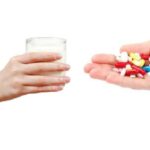Does Mother’s Milk Homeopathic Remedy Work?

Breast milk is produced by a woman’s body specifically to meet her child’s nutritional needs. It provides everything a baby’s body requires for proper growth and development, changing in response to the baby’s needs. Not only is breast milk a complete source of nutrition and hydration, it also helps protect babies from getting sick through antibodies that pass from mother to baby through the milk.
A mother’s breast milk is composed of hundreds of distinct bioactive molecules, some of which are not yet fully understood by scientists. Here are some of the other constituents of human milk:
- Millions of live cells. These include immune-boosting white blood cells, as well as stem cells, which may help organs develop and heal.
- More than 1,000 proteins that help babies grow and develop, activate thier immune system, and also develop and protect neurons in the brain.
- All that breast milk protein is made up of amino acids. There are more than 20 of these compounds in your milk. Some of them, called nucleotides, increase at night and scientists think they may induce sleep.
- Over 200 complex sugars called oligosaccharides that act as prebiotics, feeding ‘good bacteria’ in your baby’s gut. They also prevent infections entering her bloodstream and lower her risk of brain inflammation.
- More than 40 enzymes. Enzymes are catalysts that speed up chemical reactions in the body. The ones in your milk have jobs such as aiding your baby’s digestion and immune system.
- Growth factors that support healthy development. These affect many parts of the baby’s body, including her intestines, blood vessels, nervous system.
- On the subject of hormones, your breast milk contains lots of them! These clever chemicals send messages between tissues and organs to ensure they work properly.
- Vitamins and minerals – nutrients that support healthy growth and organ function, as well as help build teeth and bones.
- Antibodies, also known as immunoglobulins. There are five basic forms of antibodies and all of them can be found in a mother’s breast milk. They protect the baby against illnesses and infections by neutralizing bacteria and viruses.
What is Homeopathy?
The word Homeopathy comes from two Greek words “homoios” meaning similar and “pathos” meaning disease or suffering. It is based on the law of “Likes Cure Likes” and was first formulated by the renowned German physician Samuel Hahnemann in 1789. A minimal, homeopathic dose of a substance that would normally cause symptoms (such as the rash and itching from exposure to the poison ivy plant) in a healthy person, when given to a sick person exhibiting those symptoms, will effect a cure. This is why people can often take homeopathic Rhus toxicodendron (poison ivy plant) to cure their allergic reaction to poison ivy.
Homeopathic medicines are manufactured in accordance with the Homeopathic Pharmacopoeia of the United States (HPUS) and pharmaceutical Good Manufacturing Practices (GMP). With a history of experience spanning over 200 years, homeopathic medicines are used by millions of patients and recommended by health care professionals around the world to relieve many acute health conditions such as allergies, coughs, colds, flu, stress, muscle pain and teething. Under the care of a trained health care practitioner, homeopathic medicines are successfully used for both acute illnesses, as well as chronic conditions, like asthma, depression, hypertension, and arthritis.
According to the World Health Organization (WHO), homeopathy is the second largest medical system for primary health care in the world. It is prevalent and widely accepted in many parts of the world including Europe, where over 100 million people use it on a regular basis. In America, during the early 1900s, the most prestigious medical schools in this country were homeopathic.
Homeopathic products come from plants (such as red onion, arnica [mountain herb], poison ivy, belladonna [deadly nightshade], and stinging nettle), minerals (such as white arsenic), or animals (such as crushed whole bees). Homeopathic products are often made as sugar pellets to be placed under the tongue; they may also be in other forms, such as ointments, gels, drops, creams, and tablets. Treatments are “individualized” or tailored to each person—it’s common for different people with the same condition to receive different treatments. Homeopathy uses a different diagnostic system for assigning treatments to individuals and recognizes clinical patterns of signs and symptoms that are different from those of conventional medicine.
Use in the United States
According to the 2012 National Health Interview Survey, which included a comprehensive survey on the use of complementary health approaches by Americans, an estimated 5 million adults and 1 million children used homeopathy in the previous year. The 2012 survey also reported that although about 1.8 percent of children used homeopathy, only 0.2 percent of children went to a homeopathic practitioner. A 2016 analysis of data from this survey suggests that most adults who use homeopathic products self-prescribe them for colds and musculoskeletal pain.
In 2016, the U.S. Federal Trade Commission (FTC) announced it will hold efficacy and safety claims for over-the-counter homeopathic drugs to the same standard as those for other products making similar claims. It further stated that companies must have the competent and reliable scientific evidence the FTC requires for health-related claims, including claims that a product can treat specific conditions.
In December 2017, the U.S. Food and Drug Administration (FDA) proposed a new risk-based enforcement approach to homeopathic products. The proposed approach would call for more careful scrutiny of products with the greatest potential for risk, including:
- Those with reported safety concerns.
- Those that are not taken by mouth or rubbed on skin.
- Those for vulnerable populations.
- Those that do not meet legal standards for quality, strength, or purity.
- Those intended to be used for preventing or treating serious and/or life-threatening diseases and conditions.
Does mother’s milk homeopathic remedy Work?
Studies have shown that many human milk components have shown promise in preclinical studies and are undergoing active clinical evaluation. The protective and treatment role of fresh breast milk is particularly important in areas where mothers and infants do not have ready access to medicine.
Human milk is also a popular therapeutic remedy that has been applied as a part of traditional, natural pharmacopeia, and ethnomedicine for many years. Public health nurses have reported on the effects of fresh colostrum and human milk as a treatment for conjunctivitis, chapped nipples, rhinitis, infections of the skin and soft tissues. The discovery of growth factors, cytokines, and a heterogeneous population of cells—including stem cells, probiotic bacteria, and the HAMLET complex (human alpha-lactalbumin made lethal to tumor cells)—in human milk has led to researchers’ increased interest in human breast milk as a natural medicine. In recent years, human milk has been the focus of many types of evidence-based research. There have been a number of reports on the topical application of human milk as an effective treatment for diaper rash, atopic eczema, diaper dermatitis, and umbilical cord separation.
However, a 2015 comprehensive assessment of evidence by the Australian government’s National Health and Medical Research Council concluded that there is no reliable evidence that homeopathy is effective for any health condition. However, it is important to note that studies included in the assessment of evidence were required to meet a number of rigorous criteria (e.g., having a sample size of more than 150 participants, the highest rating of methodological quality, and other measures). In total, 57 systematic reviews that contained 176 individual studies were included in this assessment. A new review of evidence by the Australian government is currently underway.
Homeopathy is a controversial topic. A number of the key concepts underlying the theory of homeopathy are not consistent with fundamental scientific concepts as we understand them. For example, homeopathic preparations can be so dilute that a substance considered to be the “active ingredient” becomes unmeasurable, which creates major challenges to the rigorous investigation of such products. However, recent research has begun to examine physical attributes of these preparations to determine if it will be possible to characterize them in the future.
No Evidence To Support Homeopathic Immunizations
Certain homeopathic products (called “nosodes” or “homeopathic immunizations”) have been promoted by some as substitutes for conventional immunizations, but the U.S. Centers for Disease Control and Prevention says there’s no credible scientific evidence to support such claims. The National Center for Complementary and Integrative Health (NCCIH) supports the Centers for Disease Control and Prevention’s recommendations for immunizations/vaccinations.





